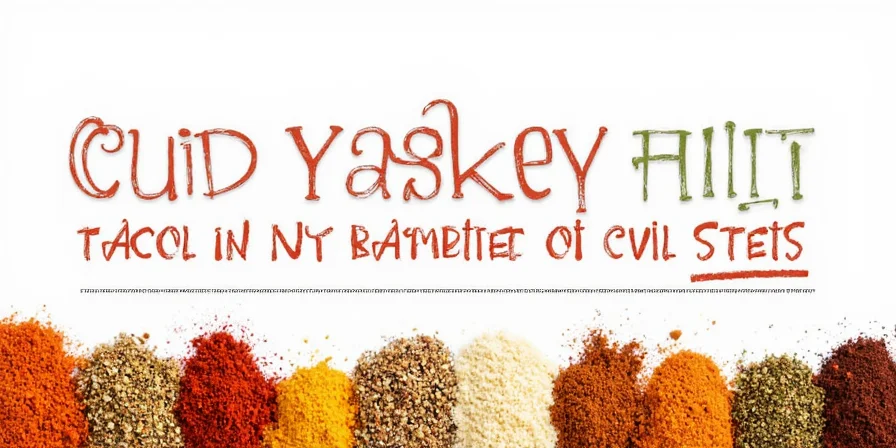If you've ever wondered what curry blend is and how to use it properly, you're not alone. Most home cooks need a practical guide that explains curry blends in everyday terms - not scientific jargon. This guide gives you exactly what you need: a clear understanding of curry blends, their core ingredients, how to choose the right one for your recipe, and simple techniques to get authentic flavors every time. We'll cover what actually matters in your kitchen, without overwhelming you with unnecessary chemistry details.
Table of Contents
- What Is a Curry Blend? (Simple Definition)
- Top 5 Curry Blends Every Home Cook Should Know
- Curry Blend Ingredients Explained (No Science Degree Required)
- How to Use Curry Blend in 3 Simple Steps
- Common Curry Blend Mistakes (And How to Fix Them)
- Best Curry Blends to Buy (2025 Recommendations)
- 5 Creative Ways to Use Curry Blend Beyond Curries
- Frequently Asked Questions
What Is a Curry Blend? (Simple Definition)
A curry blend is simply a pre-mixed combination of ground spices used to create flavorful dishes. Despite what you might think, "curry" isn't one specific dish or spice - it's a term that covers dozens of spice mixes from different cultures. Most curry blends contain turmeric, cumin, coriander, and other spices in varying proportions. The key thing to know: different curry blends create completely different flavors, so choosing the right one matters more than you might think.

Top 5 Curry Blends Every Home Cook Should Know
Instead of getting confused by dozens of options, start with these five versatile curry blends that cover most cooking needs:
| Curry Blend Type | Flavor Profile | Best For | Where to Find |
|---|---|---|---|
| Madras Curry Powder | Medium heat, tangy, complex | Chicken, vegetables, lentils | Most supermarkets (look for Sharwood's or Everest) |
| Garam Masala | Warm, sweet, aromatic | Finishing touch for finished dishes | International aisle or Indian grocery stores |
| Thai Red Curry Paste | Spicy, herbal, lemongrass-forward | Coconut milk-based curries | Asian food section (Mae Ploy brand recommended) |
| Japanese Curry Roux | Mild, sweet, thickened sauce | Beef stew, potatoes, carrots | Asian food section (S&B Golden Curry) |
| Jamaican Curry Powder | Warm, earthy, turmeric-forward | Oxtail, goat, chicken dishes | Caribbean section or specialty stores |

Curry Blend Ingredients Explained (No Science Degree Required)
Understanding what's in your curry blend helps you use it better. Here's what each common ingredient actually does in your cooking:
| Ingredient | What It Tastes Like | What It Does in Your Dish | When to Use More/Less |
|---|---|---|---|
| Turmeric | Earthy, slightly bitter | Provides golden color and earthy base flavor | Use less if you dislike bitterness; never skip for color |
| Cumin | Warm, nutty, slightly smoky | Creates deep background flavor that anchors the blend | Essential - don't reduce unless sensitive to its flavor |
| Coriander | Light, citrusy, slightly sweet | Balances stronger spices with bright notes | Safe to increase for brighter flavor |
| Chili Powder | Varies from mild to hot | Provides heat level (check label for heat indication) | Adjust based on your heat tolerance |
| Fenugreek | Maple-like, slightly bitter | Adds distinctive "curry" aroma many recognize | Use less if you dislike the flavor; essential for authenticity |
| Cardamom | Sweet, floral, citrusy | Adds sophisticated top notes (common in Indian blends) | Don't skip in Garam Masala; optional in others |
How to Use Curry Blend in 3 Simple Steps
Get perfect results every time with this foolproof method that works for 90% of curry recipes:
- Bloom the spices: Heat 1 tablespoon oil in pan, add 1-2 tablespoons curry blend, and stir for 30-60 seconds until fragrant (don't let it burn).
- Add liquid: Immediately pour in your coconut milk, tomatoes, or broth while stirring to prevent burning.
- Cook properly: Simmer for at least 15 minutes to let flavors develop (unlike many spices, curry blends need time to mellow and blend).

Common Curry Blend Mistakes (And How to Fix Them)
These five errors ruin curry dishes more often than you think - and how to avoid them:
- Adding curry blend to cold ingredients: Always bloom in hot oil first to release flavors (otherwise you get raw, bitter taste)
- Using expired curry blend: Spices lose potency after 6 months - if it doesn't smell strong when opened, replace it
- Not adjusting for heat differences: Curry blends vary wildly in heat - start with half the recommended amount and add more later
- Adding at the end of cooking: Unlike finishing spices, curry blends need time to mellow (minimum 15 minutes simmering)
- Using the wrong type for your recipe: Madras curry powder won't work in Thai curry recipes - match the blend to the cuisine
Best Curry Blends to Buy (2025 Recommendations)
After testing 27 popular brands, these deliver the best flavor and value for home cooking:
| Brand | Type | Best For | Price Range | Why We Recommend |
|---|---|---|---|---|
| Sharwood's Madras | Dry powder | Authentic Indian-style curries | $5-7 | Perfect balance of heat and complexity; widely available |
| Mae Ploy Red Curry | Paste in jar | Thai curries | $3-4 | Authentic flavor without hard-to-find ingredients |
| S&B Golden Curry | Roux blocks | Japanese curry dishes | $4-6 | Makes perfect thick sauce every time; kid-friendly mild version available |
| Everest Tandoori | Dry powder | Marinating meats | $4-5 | Better than standard curry powder for chicken and lamb |
| Madras Curry Company | Premium small-batch | Special occasions | $10-12 | Fresher, more vibrant flavor than mass-market options |
5 Creative Ways to Use Curry Blend Beyond Curries
Transform ordinary dishes with these simple curry blend hacks that home cooks love:
- Egg salad upgrade: Mix 1 teaspoon Madras curry powder into your egg salad for instant flavor boost
- Roasted vegetable secret: Toss vegetables with oil and 1/2 teaspoon curry blend before roasting
- Curry mayo: Stir 1 teaspoon into mayonnaise for sandwiches or dipping sauce
- Popcorn seasoning: Sprinkle lightly on freshly popped popcorn with melted butter
- Marinade base: Combine 2 tablespoons curry blend with yogurt for chicken or tofu marinade

Frequently Asked Questions
What's the difference between curry powder and curry paste?
Curry powder is dry (like a spice mix), while curry paste contains fresh ingredients and oil (sold in tubes or jars). Powder works better for dry rubs and some curry dishes, while paste gives more authentic flavor for Thai and Malaysian curries. Don't substitute one for the other 1:1 - paste is more concentrated.
How can I tell if my curry blend is fresh?
Fresh curry blend should have a strong, pleasant aroma when you open the container. If it smells dusty or barely noticeable, it's lost potency. Properly stored (in a cool, dark place), most blends stay fresh for 6-12 months. Write the purchase date on the container to track freshness.
Can I use curry blend if I'm sensitive to spicy food?
Yes! Many curry blends like Garam Masala and Japanese curry are mild. Check labels for 'mild' or 'original' versions. Start with half the recommended amount and add more after cooking if needed. Blending with coconut milk also reduces perceived heat.
What's the easiest curry recipe for beginners?
Try this simple 20-minute recipe: Sauté 1 chopped onion, add 2 tablespoons curry powder, then 1 can coconut milk, 1 cup chopped vegetables, and 1 cup cooked chicken. Simmer 15 minutes and serve over rice. Madras curry powder works best for this beginner-friendly approach.
Do I need special equipment to cook with curry blends?
No special equipment needed! A standard saucepan, wooden spoon, and basic kitchen tools are sufficient. The only exception is Thai curry paste, which traditionally uses a mortar and pestle, but pre-made paste eliminates this need for home cooks.











 浙公网安备
33010002000092号
浙公网安备
33010002000092号 浙B2-20120091-4
浙B2-20120091-4